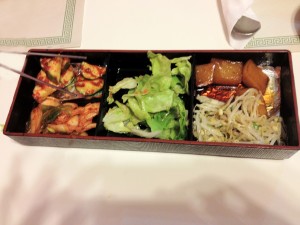A waitress brings out a long, thin plate of what looks like rotten cabbage, little pickled fish and marinated potato chunks. Soon she follows with steaming-hot stone bowls of soup or skillets filled with meat and onions.
Korean food is starting to pop up all over Utah Valley. With restaurants like Spicy Corea, Fusion and Sam Hawk, this ethnic food is starting to turn heads. The food itself can be very surprising to palates that are tuned to the American kitchen.
Matt Hadley, a senior studying international relations, served his mission for The Church of Jesus Christ of Latter-day Saints in South Korea and fondly remembers his food experience there.

“Eating and drinking are a big part of Korean culture,” Hadley said. “Many Korean foods are not easy to eat. You have to eat around bones, put together wraps or pull things out of shells. Thus, many meals are much more of an event than our American meals are.”
Hadley’s description of the food conjures up images of a raw, hands-on eating experience, but he insists the cuisine is centered around two main foods.
“The two most important food items in Korea are rice and kimchi,” Hadley said. “In fact, the words for ‘meal’ and ‘rice’ are largely interchangeable. A typical meal includes a bowl of rice for each person, a main dish and side dishes that are all shared out of the same bowl or plate. It is very poor manners to not eat all of your rice.”
Hadley also explained that there are hundreds of kinds of kimchi, enough to spur the construction of the kimchi museum in Seoul, Korea. Kimchi, a type of fermented cabbage, was originally preserved to provide food during the winter. However, when Japan invaded Korea in the 1500s, it introduced peppers to the recipe.
For Koreans, food is a central part of their culture, not just their diets. Stephen Meek, a senior studying international relations, remembers a strong connection between the food and people of Korea.
“The Korean people, remembering an era of starvation following the Korean War, are eager to enjoy their modern affluence through enormous feasts,” Meek said. “Meals are communal ventures. Boiling stews, hearty meats, spicy vegetables, rice dishes and the iconic sidedish, kimchi, are found in abundance on every table and, ultimately, in every heart of the Korean people.”
Michelle Lee, a nursing student from Los Angeles, grew up in a Korean household and understands the differences between American and Korean eating.
“One of the biggest differences between Korean food and American food is that Korean food has more spices in it and wholesome ingredients,” Lee said. “I also think Korean food is generally healthier than American food since there are more vegetables in the dishes. Another difference is that each Korean meal features a bowl of rice, side dishes and a main dish such as a soup, stew or meat.”
Lee also has some tips for Americans looking to experiment with dinner time at a Korean restaurant.
“I would go as a group and have everyone get different things,” Lee said. “I would definitely recommend Bulgogi for beginners because I haven’t met anyone that does not love it. If you are craving a dish that has more vegetables, I would recommend Bibimbap. This dish has a variety of vegetables and meat that are mixed together, and it is very tasty, loaded with flavor.”




